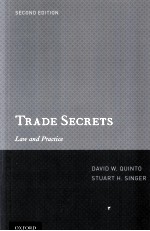

TRADE SECRTS LAW AND PRACTICEPDF电子书下载
- 电子书积分:17 积分如何计算积分?
- 作 者:DAVID W.QUINTO START H.SINGER
- 出 版 社:OXFORD UNIVERSITY PRESS
- 出版年份:2012
- ISBN:
- 页数:582 页
CHAPTER 1: What Is Protectable as a Trade Secret? 1
A. The Majority Rule: "Trade Secret" as Defined by the UTSA 3
1. Meaning of"Information" 3
2. Meaning of"Independent Economic Value" 10
3. Meaning of"Not Generally Known" 14
4. Meaning of"Reasonable Efforts to Maintain Secrecy" 16
B. The Restatement (Third) of Unfair Competition View of Trade Secrets 25
C. New York, New Jersey, and Texas: The Restatement (First) of Torts Definition 30
D. The Massachusetts Definition 37
E. The North Carolina Definition 40
CHAPTER 2: Litigating Trade Secret Actions--Plaintiff's Perspective 43
A. Alleging Trade Secret Misappropriation 45
1. Misappropriation 45
2. Improper Means 46
3. Acquisition, Use, or Disclosure 49
4. Imputed and Joint Liability 50
B. Elements of Misappropriation Claim 51
C. Alleging Alternative Claims 54
1. State Law Claims 58
2. Federal Claims 77
3. U.S. International Trade Commission Investigation 87
D. Requirement to Identify Trade Secrets with "Reasonable Particularity" 92
E. Presumptions, Inferences, and Burden-Shifting 98
1. Inferring Use from Substantial Similarity of Products 98
2. Inferring Copying from Time to Market 99
3. Spoliation of Evidence 100
4. Presumption of Irreparable Harm 102
5. Presumption of Confidentiality 103
6. Presumption of Independent Economic Value 103
F. Preliminary Injunctive Relief 104
1. Bases for Relief 104
2. Seeking a Temporary Restraining Order 119
3. Obtaining a Preliminary Injunction 122
4. Bond Requirement 126
G. Choosing an Expert 128
H. Discovery Tactics 137
I. Remedies 139
J. Settlement 143
K. Procedural Considerations 146
1. Strategic Venue Choices 146
2. Statute of Limitations 151
L. Standing 156
CHAPTER 3: Litigating Trade Secret Actions--Defendant's Perspective 159
A. Defenses 161
1. Preemption 161
2. Statute of Limitations 185
3. Other Defenses 189
B. Effect of Arbitration Provision 206
C. Challenges to the Plaintiff's Trade Secret Identification 211
D. Discovery Considerations 213
1. Potentially Patentable Trade Secrets 214
2. Trade Secrets Potentially Disclosed to the Government 216
3. Other Trade Secret Disclosures by the Plaintiff 216
4. Trade Secrets Incorporating Antecedent Works 217
5. Plaintiff's Plan to Maintain Secrecy 217
6. Damages 218
7. Equitable Relief 219
8. Attorneys' Fees 220
9. Insurance Coverage 220
E. Finding Experts 221
CHAPTER 4: Corporate Trade Secret Protection Plans and Practices 225
A. Legal Requirements and Policy Considerations 226
B. Trade Secret Audits 229
C. Trade Secret Protection Plans 233
1. Overview 233
2. Employee Education and Work Practices 234
3. Facilities Protection 236
4. Visitor Precautions 237
5. Document Security 237
6. Electronic Security 239
7. Manufacturing Security 242
8. Unsolicited Inventions and Ideas 243
9. Sample Forms 244
D. Protecting Information Disclosed to the Government 246
1. Rules of Thumb 246
2. Protecting Trade Secrets While Contracting with the Federal Government 251
3. Preventing the Federal Government from Disclosing Trade Secret Information 261
CHAPTER 5: Hiring and Terminating Employees 269
A. Hiring Employees 270
1. Hiring Concerns 270
2. Document Collection 271
3. Employment Interview 271
4. Post-Interview Precautions 274
5. Sample Employee Confidentiality and Invention Assignment Agreement 280
6. Restrictive Covenants 284
B. Terminating Employees 285
1. Conducting Exit Interviews 285
2. Conducting a Post-Termination Investigation 287
3. Post-Departure Precautions 288
4. Sample New Employee Proprietary Information Protection Letter 289
5. Sample Termination Certificate 290
6. Sample Reminder Letter to Former Employee 291
7. Sample Compliance Request Letter to New Employer 292
8. Sample Employer "Compliance Request Letter" Response 293
CHAPTER 6: Criminal Prosecution of Trade Secret Misappropriation 295
A. Whether to Seek Criminal Prosecution 296
1. Benefits 296
2. Drawbacks 299
B. Persuading the Government to Prosecute 301
C. Federal Economic Espionage Act of 1996 303
1. Overview 303
2. Protection of the Victim's Trade Secrets 306
3. Elements of an EEA Violation 306
4. Remedies 310
5. Defenses 311
D. Other Potentially Applicable Federal Criminal Statutes 313
1. Mail Fraud and Wire Fraud 313
2. Deprivation of Honest Services 315
3. National Stolen Property Act 315
4. Unlawfully Accessing or Attempting to Access a Protected Computer 317
5. Copyright Infringement 319
6. RICO 321
7. Disclosure by a Federal Employee 322
E. State CriminalStatutes 323
1. California 323
2. New Jersey 329
3. New York 330
F. Creating a Compliance and Ethics Program to Reduce Criminal Exposure 331
APPENDIX: Overview of Trade Secrets Laws of Selected States 337
A. Arizona 338
B. California 340
C. Delaware 359
D. Florida 364
E. Georgia 371
F. Illinois 377
G. Indiana 386
H. Maryland 390
I. Massachusetts 392
J. Michigan 398
K. Minnesota 404
L. Missouri 409
M. New Jersey 415
N. New York 422
O. North Carolina 432
P. Ohio 436
Q. Pennsylvania 443
R. Tennessee 450
S. Texas 454
T. Virginia 462
U. Washington 468
V. Wisconsin 472
TABLE OF CASES 479
INDEX 565
- 《地球简史》(英)戴维·贝克(David Baker) 2020
- 《第三帝国的兴亡》(英)克里斯·毕晓普(Chris Bishop),(英)戴维·乔丹(David Jordan)著 2019
- 《图解轻武器史 剑、矛和锤》(美)大卫·苏德(David Soud)著;刘恒沙译 2017
- 《现代环境主义导论》(英)戴维·佩珀(David Pepper)著 2020
- 《中国经学史》(美)韩大伟(David B. Honey)著 2019
- 《火星生命 前往须知》(美)戴维·温特劳布(DAVID A. WEINTRAUB)著;傅承启译 2019
- 《程序员修炼之道 通向务实的最高境界 第2版》(美)David Thomas(大卫·托马斯),Andrew Hunt(安德鲁·亨特) 2020
- 《谁捉住了上帝粒子?》(法)大卫·卢阿普尔(David Louapre)著 2020
- 《博士生教育的变迁》(澳)大卫·鲍德(David Boud),(澳)艾莉森·李(Alison Lee)编 2019
- 《信息系统安全基础 原书第2版》(美)David Kim 2020
- 《中国“80后”大学教师胜任力评价研究=RESEARCH ON THE EVALUATION OF CHINA'S POST 80s GENERATION UNIVERSITY TEACHERS' CO》黄艳著 2013
- 《解读好莱坞:电影的空间与意义》Deborah Thomas著;李达义,曹玉玲译 2004
- 《会说话的星图 星座篇》徐历涛著 2014
- 《可靠性工程与风险管理 第3辑 英文版》赵衍刚编 2012
- 《竞争战略 全译珍藏版》(美)迈克尔·波特(Michael E. Porter)著 2012
- 《中国材料名师讲坛 第1辑》谢建新主编 2012
- 《翻译能力的培养》舍夫娜,阿达巴编 2012
- 《大学生外语口语焦虑 自我图式的视角 for university students: in the view of self-schema》巫文胜著 2014
- 《都柏林大学的教育内涵与实践 探索世界高水平大学发展之路 explore the development of the world high-level university》李全宏编著 2013
- 《物理学 卷1 力学和热学 医学、生物等专业适用 英文改编版原书第4版》AlanGiambattista,BettyMcCarthyRichardson著 2013
